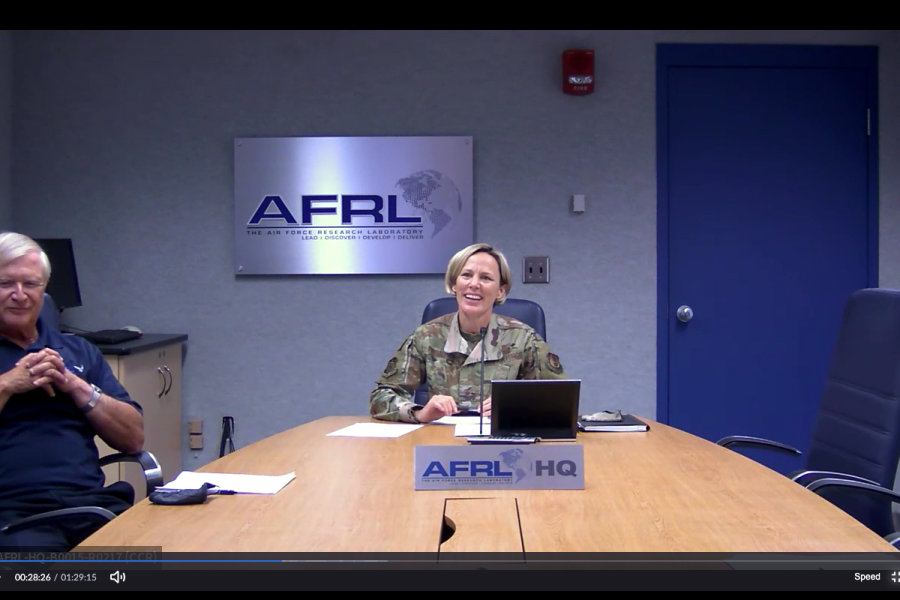The new commander of the storied Air Force Research Laboratory will realign—not reorganize—the lab so it can ably support both the new U.S. Space Force and its traditional Air Force customers.
“We’ll be one AFRL serving two services: The Air Force and the Space Force,” said Brig. Gen. Heather L. Pringle, commander of AFRL, in an interview with Air Force Magazine. A new deputy technical executive officer will be “responsible for integrating our space [science and technology] portfolio,” Pringle said, and will report directly to her. The new executive will be “the single focal point for the U.S. Space Force,” she added.
Pringle, who took command in June, said the realignment is her No. 2 priority behind implementing the Air Force’s 2030 Science and Technology Strategy.
The Space Force “controls its own money, and has its own budget, and it will set its own priorities for the [science and technology] research that it requires,” Pringle said. “Our job will be to align our force to that and execute it.”
Administratively, some 720 of the AFRL’s 12,700 military, civilian, and contractor personnel will be “chopped over to the Space Force and then reassigned back to us,” Pringle said. These will include most of today’s Space Vehicles Directorate, and parts of the Rocket Propulsion and Electro-Optical Divisions.
To personnel on the ground in the far-flung AFRL enterprise—which stretches from Wright-Patterson AFB in Ohio to Kirtland, N.M., and and as far Maui, Hawaii—the transition will be “seamless,” she predicted. “You might have a name tape change, if you’re in the military, but you’re going to have the same reporting chain.”
It’s important to keep the AFRL together, Pringle said, invoking Air Force Materiel Command boss Gen. Arnold W. Bunch Jr. who, as AFRL commander, was fond of saying, “Technology doesn’t know what it’s for.” What something is invented to do may not be where it proves most valuable.
“Space S&T is not only happening in the Space Vehicles Directorate [and the other elements being transferred], it occurs all across our lab,” Pringle said, citing materials and human effectiveness and information technology that can be applicable to the Space Force.
“We’ve been supporting space [science and technology] for decades” and continue to work on transformative space technologies.
As an example, she cited the Navigation Technology Satellite-3, an AFRL program designed to provide a more secure, next-generation alternative to GPS. NTS-3 is one of a very few Air Force Vanguard programs—high-priority projects intended to deliver strategic advantages to the U.S. warfighter.
Col. Eric J. Felt, who leads the Space Vehicles Directorate, said new technologies of interest to the Space Force and the Air Force “are not two separate circles,” but rather “overlap a lot,” as in a Venn diagram. “If you were to just chop off some people and say you’re the people that are working on space, you would miss out on the whole intersection of those Venn diagrams.”
Autonomy is one such example, Felt said, concerning development of artificial intelligence systems that can control planes and satellites. With a single AFRL, “We’re able to both work together on autonomy technology and apply it in these different domains.”
Dealing with that kind of overlap research, Felt said, was the key to success, and the new deputy technical executive officer’s “main job is to identify and make sure that the intersection of those two circles is effectively managed.”
Indeed, noted retired Maj. Gen. Curtis M. Bedke, who commanded AFRL from 2007-10, this was precisely the rationale for creating AFRL in 1997 when all the Air Force’s then-separate labs were fused into a single research enterprise.
“The real value of the Air Force Research Laboratory is that anything that is a really hard project, the projects that are of the most value to the Air Force and to the nation, have been those that require the directorates to work with each other to solve a truly important long-range challenge,” Bedke said.
“The nation can’t afford to split up these teams of scientists that have taken decades of hard work to create and to nurture,” said Bedke, now a consultant and senior fellow at AFA’s Mitchell Institute of Aerospace Studies. “You don’t want to create an artificial barrier with an organizational split and send them off on their own merry way. “
Yet the devil will be in the details, noted one former senior defense official, who asked to remain anonymous because of sensitivities with his current employer. “The real issue is who’s going to be directing the research budget and where [AFRL] will be aiming to transition successful technologies to … They have to figure out the acquisition.”
Elements of AFRL being transferred to the U.S. Space Force
- Space Vehicles Directorate (AFRL/RV) — Almost the entire directorate is transferring (one notable exception is the Atomic Long Range Systems Branch/RVBN); 419 of 441 total positions are moving to Space Force.
- Rocket Propulsion Division (AFRL/RQR) — Some parts of this division (part of the Aerospace Systems Directorate) are transferring; 74 of 138 positions are moving to Space Force.
- Electro-Optical Division (AFRL/RDS) — Almost all of this division (part of the Directed Energy Directorate), mostly based on Maui, Hawaii, is transferring; 136 of 139 positions are moving to Space Force.
- Sensors Directorate (AFRL/RY) – Positions from the Systems Technology Office are the only ones transferring from this directorate; due to the fact that its work is classified, the specific number of positions moving from this organization cannot be made available.
- Additionally, some contracting support (for mission execution) for the various transferring organizations will also transfer.
